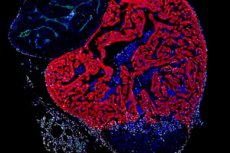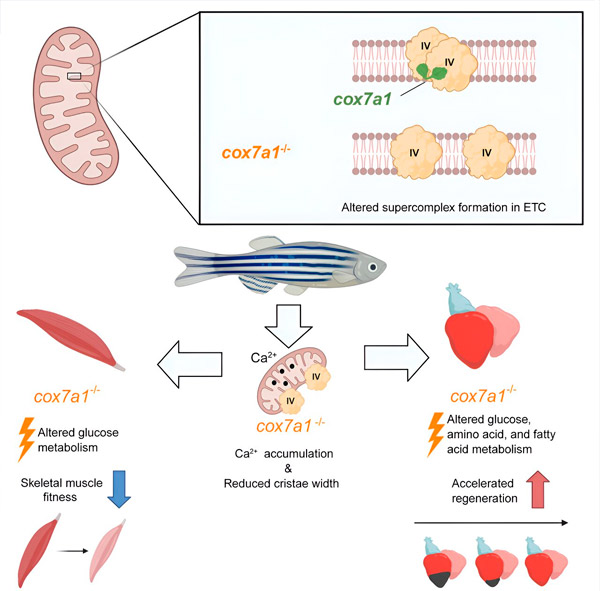
线粒体在提供细胞正常功能所需的能量方面发挥着至关重要的作用。在线粒体中,能量由呼吸链产生,该呼吸链由五个复合物(CI-CV)组成。这些复合物可以组装成超级复合物,但人们对这一过程的作用及其控制知之甚少。
这项新研究探究了超复合物组装的机制,并揭示了线粒体组装因子对心脏组织再生的显著影响。该研究由美国国家心血管研究中心 (CNIC) 的 José Antonio Enríquez 博士和瑞士伯尔尼大学、CNIC 客座科学家 Nadia Mercader 博士共同领导。
《发育细胞》杂志发表的一项研究表明,蛋白质家族成员 Cox7a 在 CIV 二聚体的组装中起着重要作用,并且这种组装对于线粒体的正常运作以及细胞能量产生至关重要。
Cox7a 蛋白家族包含三个成员:Cox7a1、Cox7a2 和 Cox7a2l(也称为 SCAF1)。这两个研究小组先前的研究表明,当 CIV 含有 SCAF1 时,它会与 CIII 紧密结合,形成一个被称为呼吸小体的呼吸超级复合物。在这些先前的研究中,作者假设 Cox7a2 的加入会导致 CIV 无法结合,而含有 Cox7a1 的 CIV 分子则会结合形成 CIV 同型二聚体。这项新研究通过实验证明了 Cox7a1 在这些 CIV 同型二聚体形成中的作用。

发育细胞(2024)。DOI:10.1016/j.devcel.2024.04.012
研究人员利用斑马鱼模型发现,Cox7a1 的缺失会阻止 CIV 二聚体的形成,而这些二聚体的缺失会影响受影响鱼的体重和游泳能力。
“Cox7a1主要在横纹肌细胞中表达,而骨骼肌组织因Cox7a1功能缺失而受损最为严重。另一种主要的横纹肌类型是心肌,”Enriquez博士解释说。
然而,虽然骨骼肌中 Cox7a1 的缺失是有害的,但心肌中 Cox7a1 的缺失却改善了心脏对损伤的再生反应。
“这一结果表明,这些蛋白质在激活心脏损伤后自我修复能力方面发挥着关键作用,”该研究的第一作者卡罗莱纳·加西亚-波哈托斯解释道。
为了进一步探索Cox7a1的功能,CNIC研究人员Enrique Calvo和Jesús Vásquez对缺乏Cox7a1的斑马鱼的骨骼肌和心肌进行了蛋白质组学研究。伯尔尼大学的同事们进行了一项代谢组学研究,补充了这项分析。这项综合分析揭示了与Cox7a1表达完整的未改造斑马鱼之间存在显著差异。
“这些结果表明,参与线粒体超复合物组装的分子可能对代谢控制产生重大影响,可能为心脏病和其他代谢疾病的新疗法开辟道路,”Mercader 博士说。
研究小组表示,这一发现代表着“在理解心脏再生所涉及的细胞机制方面迈出了重要一步,并可能为开发旨在刺激心脏再生的疗法指明方向。”
作者得出结论,线粒体组装因素可以显著影响代谢控制。

